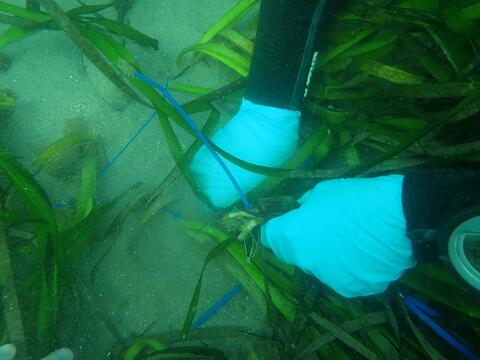UPDATE: Port of San Diego Study Unlocks Treasure Trove of Blue Carbon Information on San Diego Bay’s Eelgrass Beds
Contact: Gabriella Rodriguez, 619.904.2137, grodriguez@portofsandiego.org
As environmental champions, the Port of San Diego works to preserve the resources of San Diego Bay for many generations to come. In January 2023, the Port released the results of its first study on carbon storage in eelgrass beds. After the study was finalized and released to the public, a unit conversion error was discovered in the calculations, resulting in an overestimation of carbon storage. As a public agency that values transparency, the Port is now releasing the revised study with updated and corrected figures.
The following are the updated key findings from the study, conducted between October 2021 and June 2022:
• The bay’s eelgrass beds currently contain 170,000 metric tons of carbon dioxide (CO2), which is equivalent to the same amount of CO2 emitted by more than 37,000 cars annually.
• Every few years since 1993, the Port and the Navy have conducted bay-wide eelgrass surveys. Presently, San Diego Bay has nearly 2,600 acres of eelgrass, which amounts to 50% of all the eelgrass in Southern California and about 17% of eelgrass in the state.
• As much as 73% of the bay’s carbon is stored in the sediments of the South Bay.
• Creating or restoring eelgrass habitat could lead to more carbon storage, which could potentially support the Port’s greenhouse gas emissions reduction efforts.
This first of its kind study in California was funded through MARAD’s Maritime Environmental and Technical Assistance (META) Program, which supports and promotes emerging technologies to improve environmental sustainability in the maritime industry.
Eelgrass and other coastal “blue carbon” ecosystems have a unique ability to rapidly capture and store large amounts of carbon. Like all plants, eelgrass absorbs CO2, which is stored as organic carbon in their plant material and produces oxygen through photosynthesis. When land plants die, their carbon is released back into the atmosphere as CO2. Unlike land plants, eelgrass is submerged in water, which prevents the release of CO2. Instead, the organic carbon is sequestered into the sea floor sediments. If left undisturbed, this carbon can remain trapped in eelgrass sediments for thousands of years. Eelgrass habitats cover a small fraction of the area forests do on land, yet they can store two to five times more carbon per acre annually and do it in less time than terrestrial forests.
In addition to storing carbon, eelgrass also helps improve water quality, provides protection from waves that erode shorelines, and is a vital habitat and food source for many animals in and around the bay.
Over the next year, the Port will continue studying the relationship between eelgrass and carbon storage. Through the META program, MARAD has committed $175,000 to a second year of research, and a third partner, the U.S. Navy, has joined the effort, allowing the team to study carbon sequestration and storage in the Navy’s eelgrass restoration areas. As the study moves into its second year, the Port, the Navy, and MARAD hope to shed more light on this little studied coastal ecosystem, and its big potential to support local and regional carbon sequestration efforts.
This study is an important component to the Port’s ongoing efforts to protect the indispensable resources San Diego Bay provides to the region, and to support state and local climate planning efforts. The study also complements the Port’s growing portfolio of nature-based solution projects:
• Blue Economy Incubator projects – San Diego Bay Aquaculture, ECOncrete, and Sunken Seaweed.
• Pond 20 – an 85-acre proposed wetland mitigation bank to restore coastal saltmarsh habitat with the added benefits of carbon sequestration and ecological enhancement, among others.
• Native Oyster Living Shoreline Project – created oyster reefs to recruit native oysters, prevent shoreline erosion, and help with carbon sequestration.
• Shellfish & Seaweed Aquaculture Planning – initiating the planning effort to permit shellfish and seaweed farming for purposes such as food production, restoration, water quality improvements, biodiversity enhancement, and carbon sequestration.
About THE Port of San Diego
The Port of San Diego serves the people of California as a specially created district, balancing multiple uses on 34 miles along San Diego Bay spanning five cities. Collecting no tax dollars, the Port manages a diverse portfolio to generate revenues that support vital public services and amenities.
The Port champions Maritime, Waterfront Development, Public Safety, Experiences and Environment, all focused on enriching the relationship people and businesses have with our dynamic waterfront. From cargo and cruise terminals to hotels and restaurants, from marinas to museums, from 22 public parks to countless events, the Port contributes to the region’s prosperity and remarkable way of life on a daily basis.
ABOUT PORT OF SAN DIEGO ENVIRONMENT
Port of San Diego Environment champions the safekeeping and environmental care of our diverse ecosystems. Year after year, environmental goals are set and measured to evolve environmental initiatives – ensuring San Diego Bay remains a vibrant resource and contributes to a remarkable way of life for visitors and residents for generations to come.
